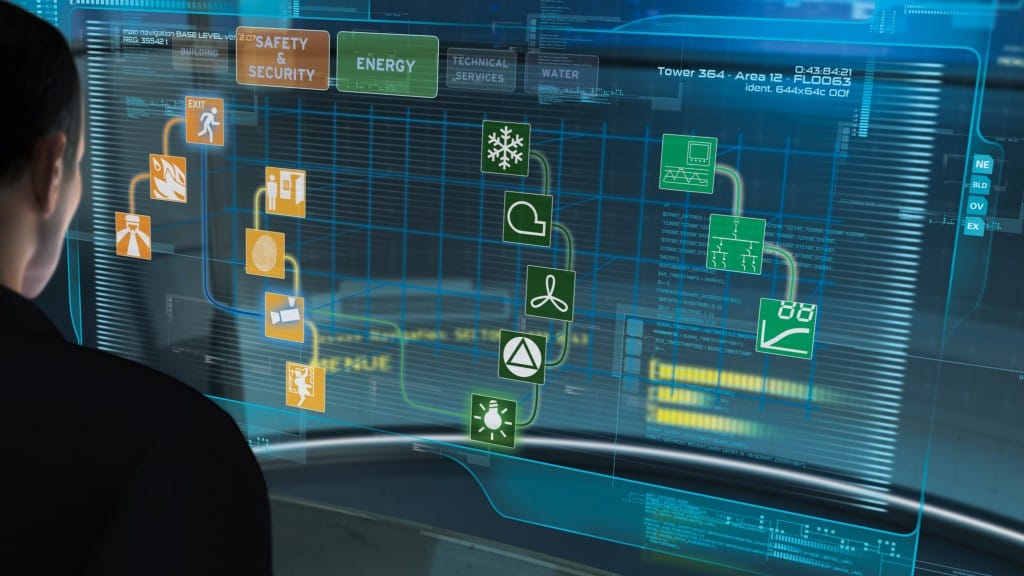Smart Buildings Reap the Technological Whirlwind

Smart Buildings, für die Siemens Gebäudeautomatisierungs- und Sicherheitstechnik anbietet, sind eine zusätzliche Möglichkeit des dezentralen Energiemanagements. Der Datenaustausch via intelligente Zähler ermöglicht es Energieversorgern, Einrichtungen der angeschlossenen Gebäude als dezentrale Energiepuffer nutzen zu können, zum Beispiel mit Hilfe thermischer Speicher oder thermoaktiven Baumaterialien. Damit übernehmen Smart Buildings die Funktion von Energiespeichern für Strom aus regenerativen Energiequellen, womit sich Lastspitzen reduzieren und Primärenergie sparen lassen. Siemens supplies building automation and security technology for smart buildings, offering an additional opportunity for decentralized energy management. The use of smart meters to exchange data allows energy providers to use the equipment, such as cooling units, located in the buildings that are connected to their systems as decentralized energy buffers. This means smart buildings can serve as energy storage units for electrical power generated from renewable energy sources, reducing peak loads and conserving primary energy.
Written by Anthony Caruana, editor of Macworld Australia
We live in a time when there’s an incredible nexus of technological changes occurring at the same time. Each change, such as wearable technology, the Internet of Things, big data and cloud technology, viewed in isolation is significant but collectively the changes represent an opportunity to radically rethink even the oldest disciplines.
Humans have been erecting buildings for thousands of years. We’ve been running electrical cables for over a century and Ethernet – the heart of data networks – is over 40 years old. But those older disciplines are coming together to herald a new age – the age of the smart building.
What makes a building smart? It’s the ability for a range of sensors and control devices to work together and manage elements of the building’s environment and utility for the occupants. At the most basic level, a thermostat is a smart sensor that regulates the operation of an air-conditioner to regulate temperature so that the users of the building are kept comfortable. But today’s smart buildings go much further.
Smart buildings integrate a massive number of sensors and control devices to manage everything from lighting to temperature to the availability of services such as elevators. Buildings interact with the outside environment to source power from the least expensive sources and pre-emptively adjust climate control systems in response to upcoming changes to the weather.
What’s coming next?
Greatly improved data management and analysis tools mean facilities managers will have much greater insight into what is happening within a building and the ability to optimise building control systems.
This will impact almost every system with the big savings to come from the ability to carry out pre-emptive maintenance by monitoring equipment through intelligent interactions with smart grids that can alter the energy use of a building according to energy cost and availability.
Beacon technology makes it possible to know more about how people use buildings. Aside from basic data around occupancy, it’s possible to track the movement of people so that systems and services can be enabled and disabled according to demand. The cost savings and environmental benefits through reduced energy use are potentially substantial.
Already, the Gugenheim Museum in New York is using similar technology to measure customer activity when looking at exhibits and retailers are employing similar tactics when optimising store space. There’s nothing stopping building designers from doing the same in all sorts of commercial and residential spaces.
Finally, the data enablement of buildings has delivered an extra benefit. Those Ethernet cables can carry more than data – they can carry power. Over the coming years, we’ll see more data-enabled devices such as wireless access points, security cameras and telephones get their energy from the network. This is will deliver significant cost savings – both through the reduction in wiring costs and through management systems that will ensure those devices are running as efficiently as possible.
Discover the future of Smart Building Technology @ Integrate 2015
Did you know Integrate has a whole educational stream dedicated to Smart Building Technology? Supported by KNX, this stream will focus on Smart Building, Converged Buildings and what the future looks like as well as the best approach in retrofitting Australia’s buildings.. Tickets are available now – view the full program here.
-
Stay up to date with the latest news, industry insights and Integrate updates.
- Subscribe
